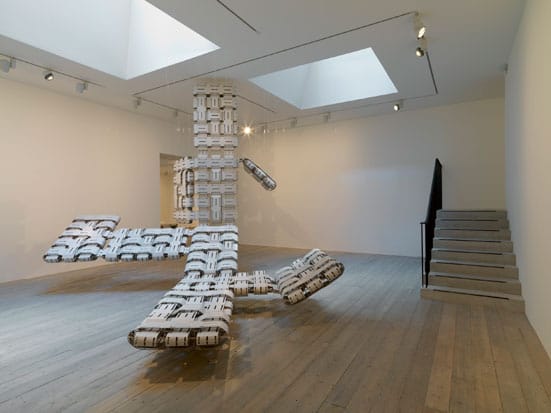28th May 2009 — 2nd August 2009
'Stretching and morphing – an elasticising – of ideas, forms and sounds' is how Raven Row links the otherwise disparate forms of artistic practise which make up its current show.
Through this exhibition Raven Row brings together sculptures and films by Thomas Bayrle and sound works and animations by Ann Lislegaard which share an aesthetic that draws on elements of sci-fi to create something which is at once futuristic, yet harks back to notions of modernism.
Encountering Bayrle's large-scale sculptures is a disorientating experience. I am at once a giant towering above an intricate network of miniature cardboard motorways reminiscent of an architect's model, elaborate children's toy or model for a futuristic space station, and yet simultaneously shrunk to molecular proportions, dwarfed by the room-sized work which takes as its form the molecular structure of the infamous SARS virus. This work from 2008, entitled SARS Formation (Modified), uses the metaphor of the motorway to describe a society in a state of constant change, a motif which is repeated in another large scale work, Autostrada, 2003, and the 16mm film Autobahn-Kopf (Motorway- Head) from 1988/89, in which a simplistic drawing of a human head is overlaid with fast moving images of urban highways, a somewhat literal visualisation equating traffic and brain activity.
Bayrle's recent sculptural works, shown in the UK for the first time here, have the quality of architectural models, as if they function as maquettes for modernist utopian cities from the future. Displayed alongside these two large scale works are a series of smaller studies, like sketches in cardboard for as yet unrealised, or perhaps unrealisable, architectural projects.
Upstairs Ann Lislegaard's animations also draw on references from science fiction. Originally shown at the 28th Sao Paolo Biennale in 2006, Lislegaard presents a double screen computer animation entitled Crystal World (After J G Ballard) which takes as its starting point Ballard's 1966 novel of the same name, in which a strange disease slowly attacks the landscape and inhabitants of a small rural village, turning them all to crystal. Originally set in Africa, Lislegaard has recontextualized the work within dense, lush Brazilian rainforest. The film guides the viewer around the interior space of a computer generated mock-up of a pristine modernist building, appearing at odds with the surrounding jungle scenery. As in Ballard's novel both building and jungle are slowly engulfed by bright white crystals which act to homogenise everything in their wake.
A second film by Lislegaard takes inspiration from a sixties sci-fi novel by Ursula K Le Guin, which tells the story of an icy futuristic planet, the inhabitants of which are neither male nor female, but who's gender appears interchangeable. Projected on three screens which overlap in the centre creating a mixing and blending of images, the work is a fast moving digital animation depicting, amongst other images, text-book style drawings of male and female genitalia which swirl around to create a somewhat hallucinogenic experience.
On the top floor of the gallery a sound work by Lislegaard, created by cutting together and remixing the sound tracks from famous science fiction movies including Andrei Tarkovsky's Solaris and Luc Besson's The Fifth Element, immerses the viewer in a strange world of whispers, truncated speech and seemingly unidentifiable fragments of sound.
Perhaps the most engaging element to this show, however, is an evolving project by the international artist / activist collective Ultra-red, who have been involved in a ten week long process of workshops and events in the gallery's project space, inviting local artists working with sound and socially engaged practise to make collaborative works under the title School of Echoes.
Ultra-red's way of working is a fluid, 'elasticising' of ideas and thoughts, the processes of collaboration and collective listening being as important as the work itself. Throughout their residency the group have facilitated a series of discussions, the remnants of which are displayed on large sheets of paper covering the walls of the space, appearing as a kind of visual archive of ideas. Participating artists then made works which explored sounds of the city in various locations which are in the process of undergoing significant social change. One work, for example, guides the listener on a walk through Queen's Market in Newham, one of the oldest food markets in London which is under threat of demolition and redevelopment by a large corporation which has the support of Newham council. This work questions the notion of gentrification and highlights the collapse of working class and minority communities. Given Raven Row's location in the heart of Spitalfields, an area which has changed beyond recognition in the past six years through redevelopment of the Old Spitalfields Market, now heaving with high class chain restaurants and City workers, this work seems to have particular resonance.
Ultra-red's investigations with sound were presented at an event in early June and will now be available to hear in the project spaces for the duration of the exhibition. In addition the group will host a series of live events, including an amplified sound walk around Elephant and Castle. Details of all the events are on the Raven Row website.
Isabelle Hancock
Raven Row
56 Artillery Lane
London E1 7LS
http://www.ravenrow.org/
Open
Wednesday-Sunday, 11am-6pm

THOMAS BAYRLE
SARS Formation (modified)
2008
Pasteboard, wood
360 x 480 x 450 cm
Courtesy Galerie Francesca Pia, Zurich; Galerie Barbara Weiss, Berlin
Photographer Marcus J. Leith

ANN LISLEGAARD
Crystal World (after J.G. Ballard)
2006
2-channel 3D animation, b/w, sound, dimensions variable
Courtesy Galerie Paul Andriesse, Amsterdam
Photographer Marcus J. Leith

Ultra-red
School of Echoes
2009
Installation view, Raven Row
Photographer Marcus J. Leith